Albania Is an Under-the-radar Food Destination — Here’s How to Plan Your Trip
With Mediterranean and Middle Eastern influences, Albania's rich culinary culture is attracting visitors from around the world.
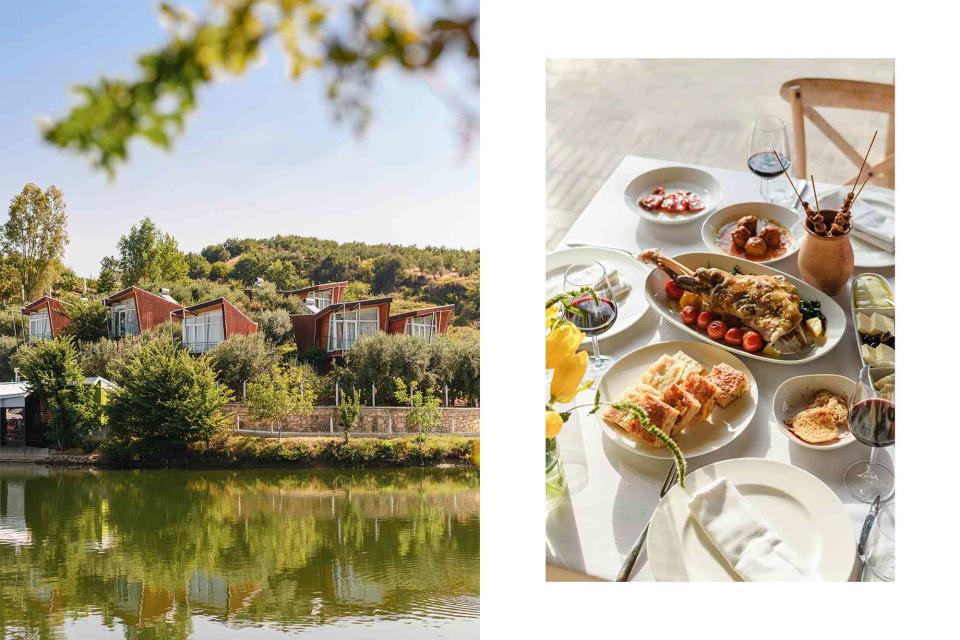
Armand Habazaj
From left: Waterfront guest bungalows at AgriTourism Huqi, located a half-hour's drive from the capital, Tirana; at Agroturizëm Gjepali, in western Albania, lunch includes lamb shoulder with baked potatoes and cherry tomatoes, meatballs, savory custard pie, and shish kebabs.As Bedri Tila lifted a wooden lid the size of a truck tire off an oven sunk into the earth, plumes of smoke and the scent of cooking lamb filled the cool morning air. We were standing on a farm surrounded by countryside in central Albania, a half-hour’s drive from the capital, Tirana. Tila and I shared no oral or written language, communicating instead in the code of curious food lovers everywhere: smiles, hand motions, and samples. Through much pantomiming, he told me he had been cooking with this technique for seven years. In Albanian, mish në pus literally means “meat in a well,” a fitting description of the subterranean oven in which he was roasting a whole lamb. Tila expertly carved off a small piece of meat and held it out for me to try.
Tila works at AgriTourism Huqi, a farm with a restaurant, a campsite, a botanical garden, an event space, even a small petting zoo. Seven modern-looking wood cabins with simple but comfortable furnishings stand on a hillside, giving guests a view of the surrounding greenery and reservoir below. The short drive from Tirana makes this destination an easy day trip for people who want to eat traditional foods, perhaps attend a wedding or birthday party, and support an agritourism industry that is beginning to flourish.
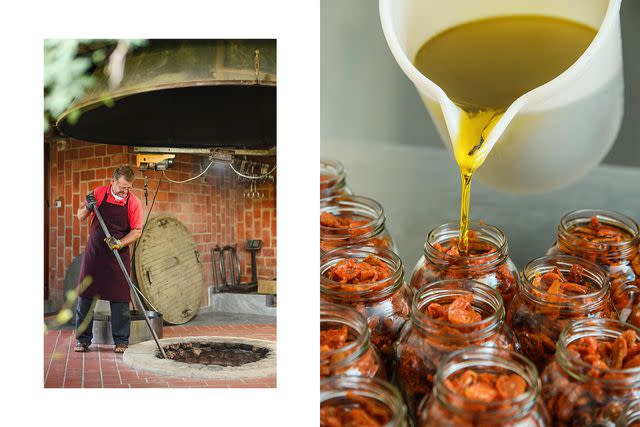
Armand Habazaj
From left: At AgriTourism Huqi, Bedri Tila prepares lamb in an underground oven; preserving sundried tomatoes at Mrizi i Zanave.Albania’s cuisine is born of the natural bounty of the Mediterranean: the country sits just 50 miles from Italy, across the Adriatic Sea. It shares dishes and ingredients with its coastal neighbors — Montenegro to the north and Greece to the south — as well as the landlocked Kosovo and North Macedonia to the east. Most importantly, Albania was ruled by the Ottoman Empire for more than 400 years, until Albania’s independence in 1912. That legacy can be found throughout the country, from the minarets gracing Tirana’s skyline to qoftë, the popular spiced meatballs.
Ruled by a brutally repressive Communist regime from 1944 to 1992, the country is now a democracy — and one of Europe’s fastest-growing travel destinations. The current prime minister, Edi Rama, is making strides in welcoming international travelers, inviting hotel brands to open properties, and advocating hard for admission to the European Union. International tourism has spiked as visitors arrive to enjoy the country’s balmy climate, nearly 300 miles of Adriatic coastline, unspoiled countryside, and welcoming, easy-to-navigate capital city.
Throughout the centuries of change, the quintessential Albanian concept of besa, a code of honor that promotes generous hospitality to strangers, has remained. The ideology holds that a home belongs first to guests and God, and then to the owner. It’s especially strong at the country’s agroturizëms, a catchall term for family-owned farms with small inns and restaurants that serve meals made from local products.
"Albania’s cuisine is born of the natural bounty of the Mediterranean: the country sits just 50 miles from Italy, across the Adriatic Sea. It shares dishes and ingredients with its coastal neighbors — Montenegro to the north and Greece to the south — as well as the landlocked Kosovo and North Macedonia to the east."
In April, I flew to Tirana to meet chefs and landowners who are reclaiming a sense of national pride and ownership through their work with food. On my first day, I left my design-forward hotel, La Suite Boutique, which sits on a quiet alley in the capital, to take a taxi 45 minutes west. The urban environment quickly gave way to centuries-old castles proudly protruding from hillsides. We hit just one small delay, which the driver said was common in these parts: a sheep-in-the-street traffic jam.
My destination was Agroturizëm Gjepali, a farm that’s been in Fundim Gjepali’s family since the late 1800s. (The nearby town, Gjepalaj, was named after his ancestors.) The property’s story traces a dark chapter of Albania’s history. Starting in 1946, behind a cloak of isolation, the government under the staunchly Stalinist Enver Hoxha expropriated agricultural lands — including the Gjepali family farm. When a democratic government was established 50 years later, it gave the Gjepali family, like countless others, about 10 percent of what they had originally owned.
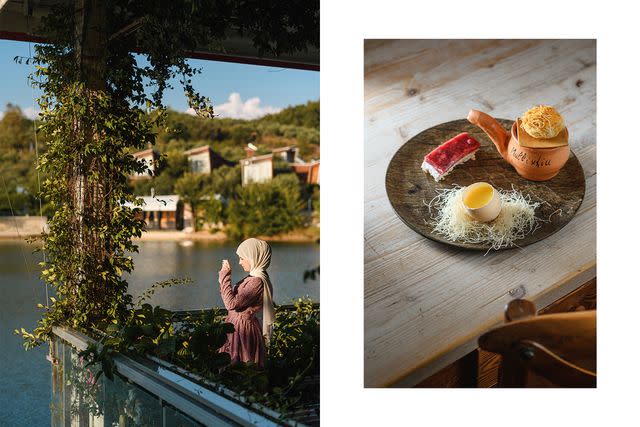
Armand Habazaj
From left: A guest takes in the scenery at AgriTourism Huqi; a dessert sampling at Mullixhiu includes yogurt cake with pomegranate, a "kadaif pipe," and custard served in an eggshell.“Thirty years after Communism, we are still emerging,” Gjepali said of his country. Albania struggled through the 1990s as the dissolution of the Eastern Bloc gave way to social unrest and financial collapse. Gjepali left for Italy at age 15, where he found work in kitchens and grew to prominence as a chef. “It was unfair for the story of my family’s home to end as it did,” he told me. He became emotional remembering what his grandfather and father had told him, when he was little, about the beauty of their lost farm. During his time in Italy, Gjepali held on to the dream of returning and reclaiming the land. Slowly, the family began repurchasing what was once theirs; thanks to their ongoing efforts, he estimates that they now own about 20 percent of what they had in 1945.
Related: The Best Food and Wine Adventures in Europe, According to Experts
I spent much of the day learning about the property. As the morning sun fell gently on the patio of the estate’s Tuscan-style building, I sipped a cup of cow’s milk that woke me up like strong coffee. It was warm and thick, with the richness of melted ice cream. The team at Agroturizëm Gjepali buys the milk from a neighbor who owns 10 cows and brings it over twice daily — one batch to pour at breakfast, the other to make into an array of cheeses and churn into butter so flavorful it tastes as if it has been browned or clarified.
Later, Gjepali’s niece, Reti Subashi, who runs operations, led me on a tour: we walked down a dirt road lined with olive trees, past fields of lettuce, potatoes, and beans, and she showed me the government-built greenhouses where cucumbers and tomatoes grow. In the afternoon, I sipped local wine on the patio and watched as a birthday party drew to a close (most of these destinations double as event venues).
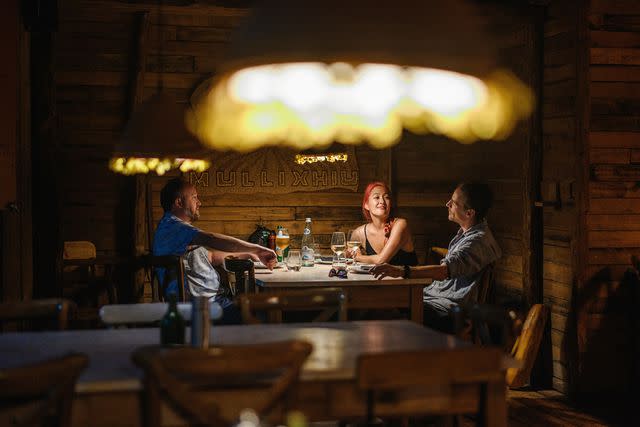
Armand Habazaj
Dinner service at Mullixhiu restaurant, in Tirana.Dinner that evening started with a parade of appetizers featuring those same tomatoes and cucumbers, salty feta-like cheese, and olives. I tried tavë balte, Albania’s ultimate comfort food: a beef-and-pepper stew thickened with ricotta-style cheese, which was faintly spicy and boldly red, almost like a creamy arrabbiata sauce. Byrek me qumësht, a savory pie of layered phyllo dough and custard, arrived at the table followed by a tripe dish with vampire-slaying levels of garlic. A pink and orange sunset lit up the sky outside the dining room as the entrées were served, followed by an equally colorful course of cut fruit.
There was a wine list, but at all the estates I visited, the only real question was red or white (the house wine is usually good, sometimes great, and always generously poured). Subashi told me visitors used to be resistant to Albanian bottlings, but, because Agroturizëm Gjepali’s menu offers only local wines, people had been forced to try them — and realized they liked them. “Now people trust that Albanian wine can be good,” she said. The estate outsources production of its red blend (a combination of Merlot and an Albanian grape called Shesh i Zi) and its white (made from another local variety, Shesh i Bardhë). Meanwhile, the family has set aside land with plans to start a winery someday.
More Trip Ideas: 25 Best International Destinations for Solo Travel
Some of the funding for opening Gjepali and its future projects, like the vineyard, came from the government. In his successful 2021 campaign for a third term, Rama prioritized tourism, facilitating the arrival of hotels from international companies like Meliá and Radisson, slated to open in the coming years. In 2023, he declared Albania’s Vjosa River — the last major river in Europe to be uninterrupted by dams or power stations — a national park. The proprietors I spoke with said that Rama’s funding programs had helped them build the kind of rural restaurants and farm stays that promote a slower, more deliberate style of tourism. “It’s much better for me to serve a hundred people the way I want to, rather than five thousand,” Gjepali said. He knows change is coming — especially with negotiations under way for Albania to join the EU after more than a decade of candidacy. But he hopes that small-scale tourism can preserve the country’s character and values.
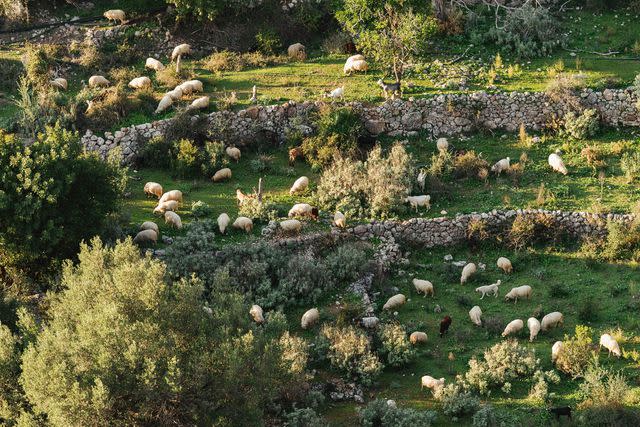
Armand Habazaj
Sheep graze in Vlorë county, in southern Albania.The next day, back in Tirana, I spoke to Bledar Kola, the chef-owner of Mullixhiu restaurant, about his past. He left Albania at age 15 and worked his way up through Michelin-starred restaurants like Le Gavroche, in London, followed by internships at the pioneering (now shuttered) Fäviken, in Sweden, and Noma, in Copenhagen. But while a dinner at Noma runs upwards of $580, Kola’s eight-course tasting menu of Albanian cuisine cost me a mere $29.
Kola, like Gjepali, was born at a time when complaining about the quality of bread could get a person thrown in jail for years. (Under Communism, bakeries, like all businesses, were owned by, and were thus an extension of, the government.) His goal now at Mullixhiu is to get people to fall in love with the country through their stomachs. “I can make it happen,” Kola said. “All I need are my pans and a pot and a fire.”
"I tried tavë balte, Albania’s ultimate comfort food: a beef-and-pepper stew thickened with ricotta-style cheese, which was faintly spicy and boldly red, almost like a creamy arrabbiata sauce."
The night I dined there, he served bozë, a fermented corn beverage, as a welcome drink, and layered the supple stacked-pancake dish fli with tender braised beef cheeks. A mill sat in the restaurant window, used for crushing grain for bread and petka, a pasta stirred with stock to create a dish similar to risotto.
Even in urban Tirana, Kola supports Albanian agriculture through his sourcing. “We are trying to feed two kinds of people,” he explained: the customers who sit at his restaurant and the producers who raise the animals and grow the fruits and vegetables. Albanian manufacturing, such as making cars or machines, contributes very little to the national economy, “so the country needs tourism,” Kola told me. But he’s emphatic that tourism should be sustainable and beneficial to everyone involved. “Our industry must not be mass tourism,” he said. “The best things we can offer are food, food culture, and nature.”
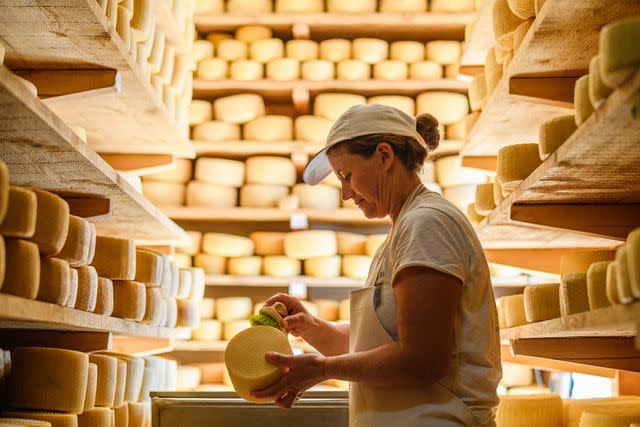
Armand Habazaj
At Mrizi i Zanave, staff member Valmira Topalli cleans the rind of a one-year-old goat cheese.A ninety-minute drive north of Tirana, chef Altin Prenga and his brother Anton welcomed me to another thriving estate, Mrizi i Zanave. Like many of their peers, the brothers first dreamed up Mrizi after relocating, in this case to Trentino-Alto Adige, in Italy, for work. After a few years they returned to their family farm, and in 2010 the pair opened the restaurant, which pulls from the property’s 50 acres as well as dozens of small farmers in the surrounding area to serve multicourse lunches and dinners. In 2018, Altin and Anton decided to remodel an old stone building into a guesthouse, elegantly replacing a crumbling stone corner with two stories of glass. The final result offers a handsome visual reminder of what these establishments do so well: sharing traditions through a window — literally, in this case — of modernity.
More Trip Ideas: 25 Under-the-radar European Villages to Visit
Four years ago, the brothers started transforming what had once been a Hoxha-era jail into a production facility, where the staff would have more room to make wine, cheese, jams, pickles, and cured meats. When I arrived, a cheerful waiter led me through the low-slung brick building, explaining its history. Behind each door, a room that once housed prisoners now stored cured meat and shelves of jarred tomatoes, strawberry jam, pine syrup, or quince compote. A woman stirred jars of onions and pickles, while nearby jugs of raki, a traditional brandy that’s often made at home, sat infusing with walnuts or mulberries. I sampled soft cheeses at the dairy, which collects cow and goat milk from 40 farms and turns them into delicacies like kaçkavall, a local variety that’s aged, herbed, and spiced. In the center of the complex, a brick tunnel slopes underground to an airy cellar filled with barrels of house wine. Standing in the modern tasting room, I felt as though I might be in Tuscany or Napa. But after I exited and stood in the courtyard surrounded by stout walls, however, the original purpose of the building remained clear.
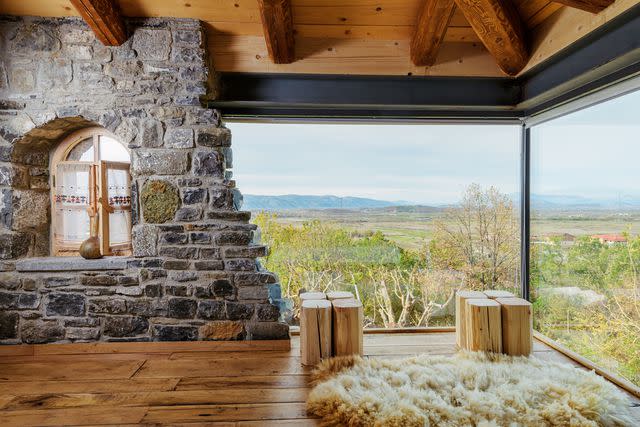
Armand Habazaj
Inside one of the rooms at Mrizi I Zanave's renovated guesthouse.My guide had to hurry back to the restaurant for his shift, so I lingered outside near the animals, offering corn to the resident baby goats who gently nuzzled my hands. I wandered the paths around the building, watching the solar-powered grain mill at work, stopping to buy edible souvenirs at the gift shop, and listening to the geese and ducks honk out symphonies until dinnertime.
After a restful sleep at the renovated guesthouse, the next morning I found myself standing once again next to an outdoor oven. This time, a team of cooks in blue aprons baked satellite-dish-size pans of byrek, savory pastries filled with pumpkin or spinach and layered with cornmeal from the mill. Later that day, as I tasted an enchantingly herbal bay-leaf ice cream, a large family group ordered several pours of house-made raki. With shouts of “Gëzuar!” they raised their glasses in a toast.
Where to Stay
AgriTourism Huqi: In Durrës county, seven sleek wooden cabins stand on columns overlooking a reservoir where guests can fish or rent paddleboats. The restaurant uses produce from the surrounding organic orchards and fields.
Agroturizëm Gjepali: Just a 20-minute drive from the Adriatic coast, this sixth-generation family farm includes a hotel and a restaurant where chef-owner Fundim Gjepali offers a standout tasting menu.
La Suite Boutique Hotel: This property, which has 12 rooms accented with jewel-toned velvet chairs and headboards, sits in a quiet alley in Blloku, a residential neighborhood in the capital, Tirana.
Mrizi i Zanave: The stone guesthouse at this estate, located in Lezhë county, in northwestern Albania, was renovated in 2018. Floor-to-ceiling glass walls offer views of the surrounding countryside.
Where to Eat
Mullixhiu: This upscale Tirana restaurant sources ingredients for its eight-course tasting menu from the region’s producers. Dishes range from zucchini salad to quail in plum sauce.
Restorant Bardhi: An ode to traditional Albanian fare (including house-made raki), this establishment sits outside the medieval Krujë Castle.
Plan Your Trip
AgroTimeAL: This app and website, created with support from the Albanian government, has a thorough directory of the country’s agritourism sites, with info about stays, tours, and restaurants. Locations are available as a list or on a map.
How to Book
T+L A-List travel advisor Daria Westerfield (dasha@riveroakstravel.com; 713-
665-4767) specializes in Central and Eastern Europe. She can arrange trips to Albania that might include shopping at the artisan bazaar in the town of Krujë, dining alfresco at the 16th-century Lekursi Castle on the southern coast, and kayaking on Lake Ohrid along the North Macedonian border.
A version of this story first appeared in the July 2023 issue of Travel + Leisure under the headline "In Season."
For more Travel & Leisure news, make sure to sign up for our newsletter!
Read the original article on Travel & Leisure.

